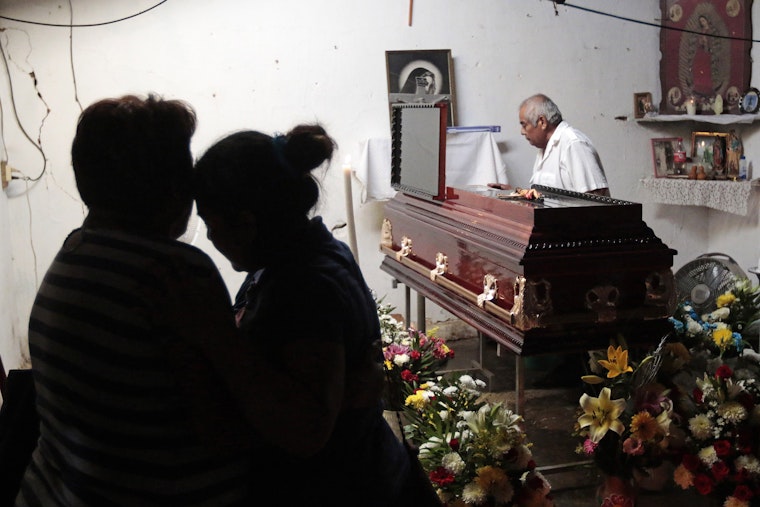Activist’s Murder Adds to a History of Atrocities in Mexico’s Guerrero State
By Eric Witte

Over the past 10 months, investigators have unearthed at least 129 bodies in hidden, unmarked graves in the hills around the town of Iguala, in Mexico’s southern state of Guerrero. They have probed the ground, gently removing bones and articles of clothing, for testing against DNA samples from the family members of people who have disappeared.
The searches were not organized by state or federal investigators responding to last September’s disappearance in Iguala of 43 students from a nearby rural teachers’ college; they were led by grieving families of the many more people who have disappeared in the area, in an effort organized from a church basement by activists like Miguel Ángel Jiménez Blanco.
An active member of the community group Union of Towns and Organizations of the State of Guerrero (UPOEG), Jiménez Blanco had previously organized women to form armed community police patrols in areas near the city of Acapulco where official police have preyed on, rather than protected, local residents.
On Saturday, Miguel Ángel Jiménez Blanco’s body was found in the taxi he drove in the small town of Xaltianguis, shot twice in the head. His killing was hardly the first indication that he was in danger. UPOEG had previously requested protection measures from Mexico’s National Human Rights Commission and its state-level counterpart.
In Guerrero, Jiménez Blanco’s killer might be a member of an organized crime gang involved in kidnapping for ransom, the lucrative heroin trade driven by a booming U.S. market, or other rackets. Or the killing could just as well have been carried out by a municipal, state, or federal agent working in collusion with organized crime, or seeking to cover-up state-perpetrated crimes. If Guerrero stays true to form, we will never know.
Jiménez Blanco was one of 15 people killed over the weekend in Guerrero, ten of them in the city of Acapulco alone. In the first eight months of this year, there have been over 450 murders in the once-glamorous resort. Through June, there had been 1,262 killings statewide, and as of April 2015, 666 people remained disappeared in the state.
Clearly, the attack on students from the Ayotzinapa teachers’ college and the disappearance of 43 of them, which gripped Mexico and drew world attention last September, did not mark the last chapter in Guerrero’s crisis of atrocity.
Nor were the Ayotzinapa disappearances the start of Guerrero’s crisis. When the Mexican government deployed federal forces domestically to fight drug gangs at the end of 2006, rates of killing, disappearance, and torture in Guerrero spiked upwards as part of a national trend. From 2005 through 2014, over 19,000 homicides were reported to state prosecutors. In 2014, again, Guerrero had the highest rate of killing in Mexico; Acapulco and the state capital Chilpancingo were the two deadliest cities in the country.
Guerrero also suffered during Mexico’s “dirty war” against leftists from the late 1960s through late ’70s; last year, a state truth commission concluded that Mexico’s military and other state agents committed crimes against humanity in the state.
Meanwhile, the federal government has almost entirely failed to provide justice for atrocities in Guerrero that fall under its jurisdiction—with its alarming mishandling of the Ayotzinapa investigation only one recent example. At state level, too, the government’s failure to provide justice for these crimes has been nearly total.
Only 6.5 percent of killings reported to state prosecutors from 2005 through 2014 resulted in a criminal conviction. Guerrero’s prosecutors have issued not a single indictment for the crime of enforced disappearance (in which state agents are the perpetrators) despite numerous cases documented by the state Human Rights Commission. Likewise, despite over 100 complaints of torture that the commission has referred to prosecutors, no torture case has ever been prosecuted in the state.
Why has Guerrero’s justice system failed the state’s citizens so badly? A report by the Open Society Justice Initiative and local partner organizations to be released in September—Broken Justice in Mexico’s Guerrero State—will examine this question in detail.
The short answer is that the failures are systemic and rooted in a lack of political will. Justice institutions are riddled with corruption, and many officials are in collusion with organized crime. Investigative police rely extensively on torture to support shoddy investigations, and have been widely accused of engaging in enforced disappearances; it is no surprise that they don’t investigate themselves for these crimes.
Under past governors, the executive has tightly controlled the prosecutor, interfered with the judiciary, been immune to control from the state congress, and neutralized the one state institution that sought accountability for atrocities: the Human Rights Commission. There are holes in the legal framework, including serious deficiencies in the state law on torture. And even when state laws meet international standards, as the law on enforced disappearance does, prosecutors and other officials fail to enforce them.
A new congress will take office on September 13, followed by a new governor on October 27. There are numerous steps they could take to chart a new course for the state, away from recurrent atrocities, injustice, and the mounting specter of instability. The first of many difficult steps for Guerrero’s new leaders will be to acknowledge the nature and dimensions of the crisis.
Meanwhile, Guerrero’s terrorized citizens will continue to scour the hills, looking for mass graves that may hold their disappeared loved ones. For now, they can rely on no one else.
Correction (August 20, 2015): This post was updated to correct the location where Miguel Ángel Jiménez Blanco’s body was found, and the date on which the new congress will take office in Guerrero.
Eric Witte is the senior project manager on national trials of grave crimes for the Open Society Justice Initiative.